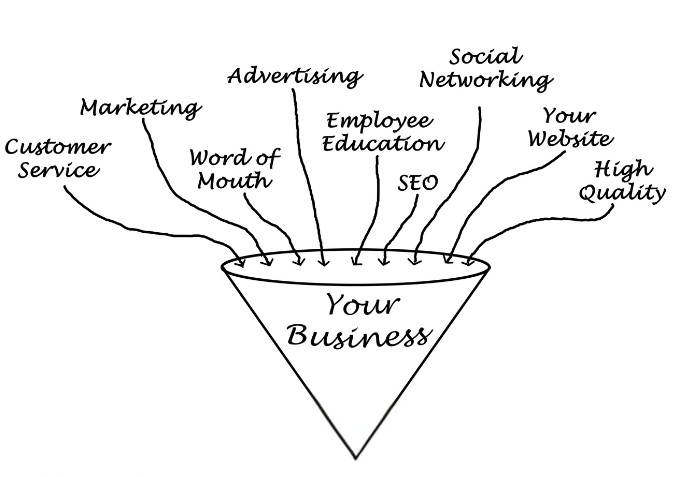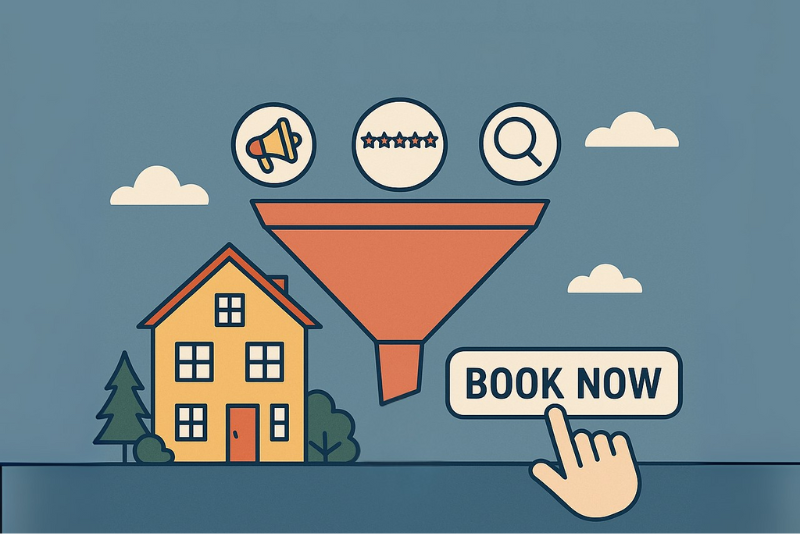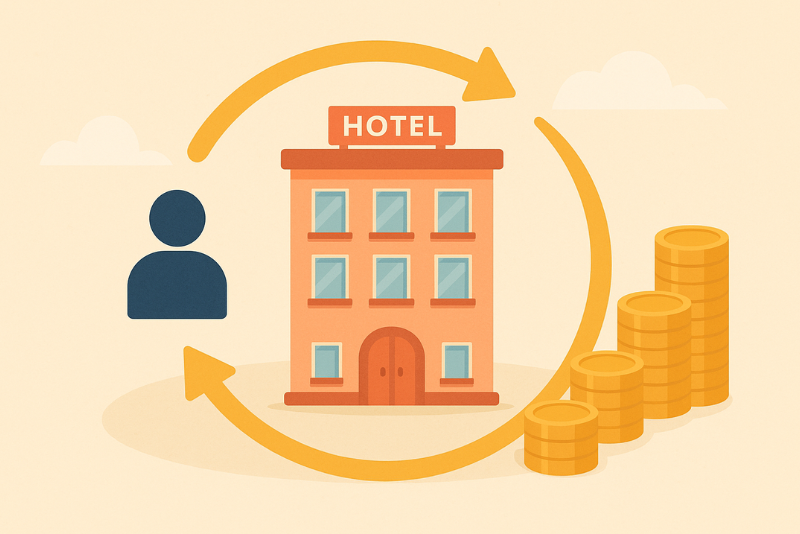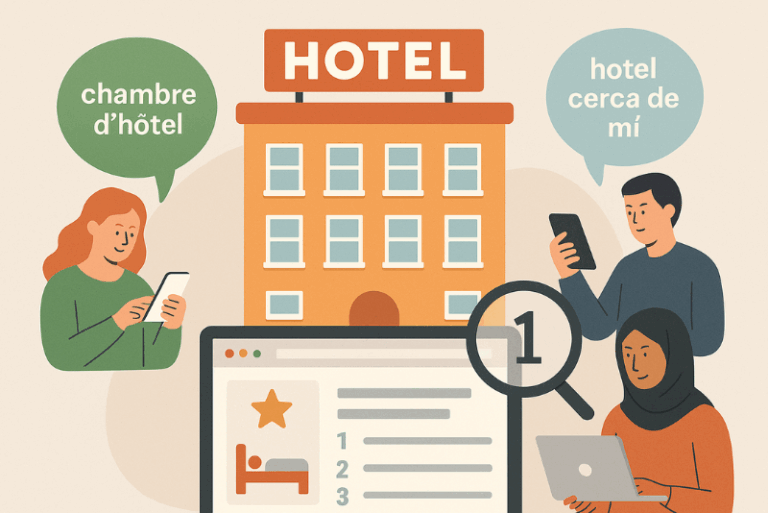How to Build a Direct Booking Funnel For Your Hotel That Converts
OTAs work. They spend billions on marketing every year and bring in bookings consistently. There’s a reason they dominate the travel industry.
But they also take a 15–20% cut of every reservation — and they do everything they can to keep you from building a direct relationship with your guests.
They control the contact information. They mask guest emails. They make sure the booking stays within their ecosystem.
And it makes sense — for them. That’s their business model.
But what about yours?
This article will show you how to build your direct booking funnel for your hotel. Not a tech gimmick. Not a one-time campaign. A simple, scalable system that turns strangers into guests — and guests into future bookings.
First Things First: Build the Foundation

Before you think about fancy tools, retargeting ads, or AI-driven automations, you need the fundamentals.
Think of your direct booking funnel like a house. You don’t start with skylights or hot tubs. You start with the foundation.
That foundation depends on three things:
- Guests can find you
- Guests trust you
- Guests can easily take the next step
Get these three right, and everything works. Get them wrong, and your whole system collapses.
Let’s start at the top.
Top of Funnel: Be Seen by the Right Guests

You can’t convert people who don’t know you exist.
At the top of your funnel is visibility — the part where potential guests are searching, browsing, or being inspired to take a trip.
There are three key ways to drive visibility. You should be doing all three.
1. Ads (Fast to Launch)
Google Ads and Meta Ads (Facebook, Instagram) are your quickest way to get traffic.
Use them to:
- Target people searching for terms like “Hotel in X city,” “X Accommodation”
- Promote last-minute offers or seasonal availability
- Remind past website visitors to come back and book
Ads are great for generating demand quickly. But once you stop paying, the traffic stops too.
2. SEO Content (Slow, Scalable, and Worth It)
Search engine optimization (SEO) takes time, but it’s one of the best long-term strategies you can invest in.
Write articles and guides that answer the questions your guests are already Googling:
- Where should I stay in X City?
- What to do in X
Structure your content properly with clear headings, readable formatting, and internal links to your booking page or inquiry form.
Post consistently — once or twice a month is enough to gain traction over time.
Use Google Analytics to track your progress and watch traffic to your site increase over time.
3. Reviews (The SEO Shortcut)
Reviews do two powerful things:
- They help your hotel show up in Google Maps, Tripadvisor, and OTA searches
- They build trust when guests are comparing options
Ask guests for reviews after checkout, especially if they’ve had a great experience. Google reviews help your site rank locally, and Booking.com/Expedia reviews help you win clicks within the OTA platforms themselves.
Effort vs. Impact Matrix
| Method | Time to See Results | Effort Required | Long-Term Value |
|---|---|---|---|
| Ads | Fast (days) | Medium | Medium |
| Reviews | Medium (weeks) | Low | High |
| SEO Content | Slow (months) | High | Very High |
Middle of Funnel: Build Trust Quickly

Once guests land on your site, they’re trying to decide one thing:
“Can I trust this place?”
They’ve never met you. They’re planning an expensive trip. And they’ve got 10 tabs open. This is your moment to earn their confidence — fast.
Visual and Structural Trust Builders
- Mobile-first design: Your site must load quickly and look clean on a phone
- Simple navigation: Can they find rooms, pricing, and FAQs in one or two taps?
- Clear CTAs: “Book Now,” “Check Availability,” “Get a Quote”
Design isn’t about beauty — it’s about clarity and trust.
Psychological Trust Signals
- Showcase genuine guest reviews and testimonials
- Use professional photography that matches reality
- Add badges for awards, “Trusted by,” or media features
Don’t just say you’re trustworthy. Show it.
Content That Removes Doubt
Guests have questions. If your site answers them, they’ll stay. If not, they’ll bounce.
Add:
- FAQ pages
- Distance maps to local attractions
- Comparisons between room types
- Local guides or nearby restaurant suggestions
When in doubt, ask: What does a guest worry about before they book? Then answer it.
Bottom of Funnel: Convert and Capture

If someone is ready to book or inquire, don’t make it difficult.
This is where most hotel sites fail — by not collecting the right info, not following up fast, or having a clunky booking experience.
What You Must Capture
At a minimum, your booking or inquiry form should ask for the following:
- Name — so your communication can be personal
- Email address — so you can follow up and send offers
- Phone number (preferably WhatsApp) — so you can quickly answer questions and reduce drop-off
This information should feed directly into your CRM or guest tracking tool. If you don’t have one yet, even a well-structured spreadsheet works.
Don’t lose contact just because they didn’t book right away.
What Makes a Good Inquiry Form
- Mobile-optimized
- Short and clear (don’t overwhelm)
- Relevant questions: arrival dates, guest count, preferences
- Auto-responder: “Thanks for your request! We’ll get back to you shortly.”
If you take more than 24 hours to follow up, you’ve likely lost the guest.
Why This Matters
You don’t need to close the sale on the first click.
But you do need to capture the lead so you can keep the conversation going.
That lead becomes:
- A direct booking
- An upsell opportunity
- A return guest
- A review
And it starts with a simple form.
Improve Over Time — Don’t Overbuild Too Soon

Once your basic funnel works, then you can add sophistication.
Ways to Improve Over Time
- A/B test your website headlines, hero images, and call-to-action buttons
- Use retargeting ads to re-engage people who visited but didn’t book
- Automate email sequences for pre-arrival info and post-stay review requests
- Use a proper CRM to track inquiries, bookings, upsells, and lifetime value
But don’t try to build everything on Day 1.
Get version 1 out the door. Start simple. Improve over time.
You’re not building a marketing campaign. You’re building a system that earns bookings every week — without constant input.
Conclusion: Guests Want to Book Direct — If You Let Them
Most hotel owners and operators don’t lose bookings because they’re bad at hospitality.
They lose bookings because their site is invisible. Or untrustworthy. Or hard to navigate. Or doesn’t follow up.
That’s the job of the funnel:
- Get seen
- Build trust
- Make it easy to act
- Capture contact
- Follow up consistently
Direct bookings aren’t about luck. They’re about systems.
And the sooner you build yours, the less you’ll depend on anyone else to fill your rooms.
Ready to Find the Gaps?
Take the free Hotel Scorecard — a 6-minute diagnostic to uncover what’s working, what’s missing, and where your funnel is leaking bookings.








